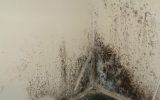Cold cellar leaks in a cantina are a common occurence, particularly when there have been heavy rains or snow has melted during the spring thaw. Once the precise point of water entry has been established, unlike basements, it is usually very easy to prevent future leaks at minimal cost.
Facts about cold cellar / cantina leaks
The number of calls we receive from homeowners with leaks in their cold cellar is truly mind boggling and most of the calls come after heavy rains. When homeowners discover water on the floor in the cold cellar they usually attribute the water to a basement leak; however, this is seldom the case. In fact, most cold cellar / cantina leaks are caused by water entering the cold cellar from the top of the foundation wall; this is a very significant fact. Why? Because no amount of foundation waterproofing will resolve water entering from the top of the foundation – so digging around the cold cellar and waterproofing it is not usually the appropriate fix. Digging and waterproofing the cold cellar walls only makes sense if the water is coming through the walls – agreed?
What To Do When You Discover a Leak in Your Cold Cellar
The first thing to do is figure out how water got into the cold cellar, this is accomplished by visually inspecting the interior of the cold cellar; a simple task if the cold cellar is unfinished. If the cold cellar is finished, a more sophisticated inspection is required. The purpose of the inspection is to determine if the water is coming through the foundation walls or from the top of the walls. Water that is coming through the walls is classified as a basement leak while water originating from the top of the foundation wall is a building envelope leak. Both types of leaks cause a wet and damp cold cellar.
The Most Common Cold Cellar Leaks


You will find a considerable amount of information on the subject of basement leaks throughout our website. Bona fide basement leaks through foundation walls are easy to identify, we have provided many pictures of obvious leaks on our Typical Sources of Basement Leaks page.
If you have determined that the water in your cold cellar is the result of a foundation leak, visit one of the following two pages which are specific to the type of foundation that you have:
Poured Concrete Foundations
Concrete Block / Cinderblock Foundations
If you have determined that the water in your cold cellar is not the result of a basement leak, the associated water ingress is a breach through the building envelope; consequently, the repair approach for this type of situation must be from the exterior. Repairs from the interior will generally trap water, which is undesirable, and are generally ineffective and definitely more costly than addressing the leak from the exterior of your home.
Why you have a leak in the Cold Cellar
Having ruled out a basement leak through the foundation walls, water entering your cold cellar will usually be attributable to ingress via one or more of the three locations in the following illustration:

Water that has entered the cold cellar through a crack in the concrete slab (location 2) requires a very specific and costly repair process which is beyond the scope of this discussion. Most cold cellar leaks are caused by water ingress at locations 1 and 3. To confirm the precise point of water ingress, using your garden hose, allow water to flow freely on the porch slab while ensuring that the water has an opportunity to enter through both locations; you should expect that water will enter the cold cellar within a few minutes.
How To Fix Cold Cellar Leaks
Water entering via locations 1 and 3 can be prevented through a simple application of caulking; however, interlocking patio stones installed over top of the concrete slab require their removal around the perimeter in order to access location 1 in particular.
The caulking to be used must be suitable for exterior window and door applications. Note that caulking must be applied to a dry and perfectly clean surface and cannot be applied when the temperature is less than 5 degrees celsius. If these conditions cannot be met, you can use plumber’s putty, available at hardware stores, as an interim measure.
The most common point of water ingress is location 3 (see diagram above). Location 3 is a seam / joint between the top of the foundation wall and the porch slab. In most cases water penetrates this joint because there are front steps trapping water on the joint or the joint is at or below grade; in both of these cases a landscaping solution is called for. It is possible to fix these leaks from the inside but an interior repair will not be as long lasting as a landscaping adjustment.







